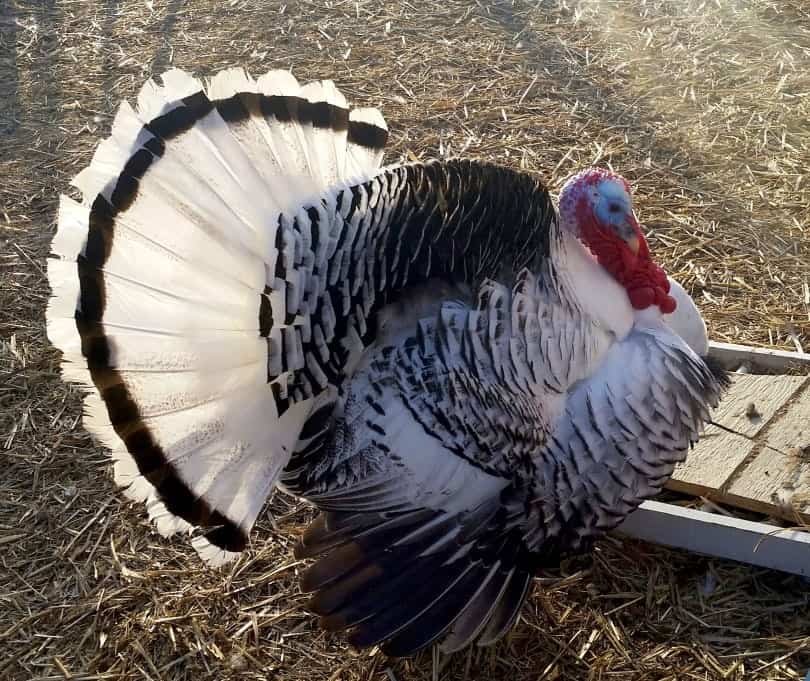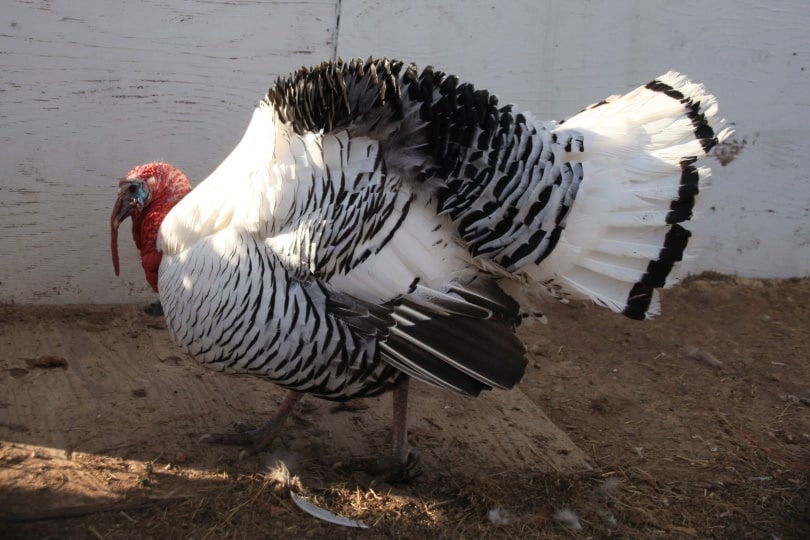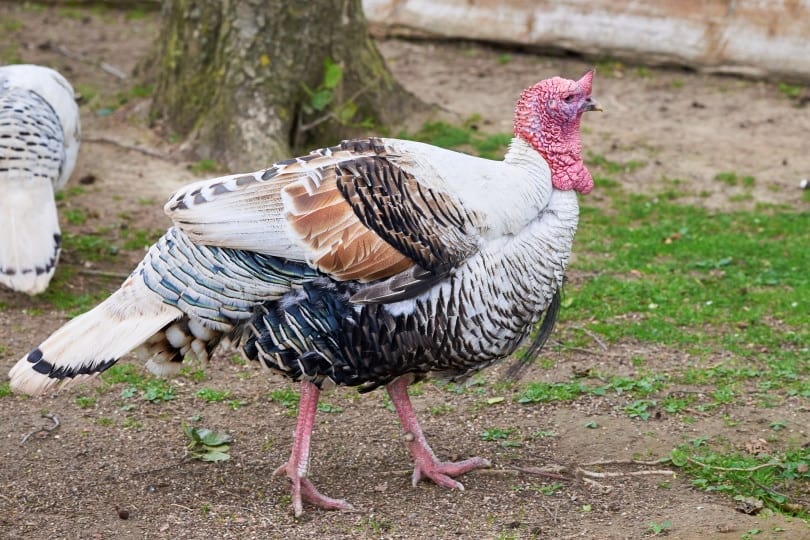While some may prefer not to think about their Thanksgiving turkey before it lands on their table, the fact is there are many different breeds of turkey, some of which are surprisingly beautiful. One such bird, the Royal palm turkey, is also a potentially useful addition to your small-scale farm. Read on to learn more about these small but fancy turkeys and decide if you want your homestead to be a little more royal!

Quick Facts about the Royal Palm Turkey
| Breed Name: | Royal Palm Turkey |
| Place of Origin: | United Kingdom |
| Uses: | For exhibition, meat, pest control |
| Tom (Male) Size: | 16-22 pounds (7.25-10 kg) |
| Hen (Female) Size: | 10-12 pounds (4.5-5.5 kg) |
| Color: | White with black-edged feathers |
| Lifespan: | 2-3 years |
| Climate Tolerance: | Most climates |
| Care Level: | Easy |
| Production: | Primarily used as show birds |
Royal Palm Turkey Origins
Royal Palm turkeys originated as a color variation among several breeds of European and English turkeys, the English Pied, Ronquieres, and Crollwitzer. In America, the Royal Palms were first noted in Florida in the 1920s. From these first uniquely colored specimens, the Royal Palm breed was further developed and standardized before being officially recognized in 1971.

Royal Palm Turkey Characteristics
Royal Palm turkeys are small, active, beautifully colored birds. They’re excellent flyers, to the point that they’re considered a flight risk if not kept in a completely enclosed location. If kept free-range, Royal Palms are hardy and good foragers, able to nest in trees if no other shelter is available.
Because these birds are often kept as pets and show birds, their temperaments are quite dependent on how they are raised and socialized. Royal Palms can be very friendly and social or show more unpleasant attitudes. In general, the males do tend to be non-aggressive compared to some other breeds. Hand-raised Royal Palms often have very intriguing personalities, curious and eager to spend time near humans.
Female Royal Palms are known for being excellent mothers. The breed can mate naturally due to their small size. Hens lay 10-12 light brown eggs, usually in early spring, and incubate them for about 28 days. Because the breed was developed primarily for their looks, they aren’t as muscular or fast-growing as typical meat turkeys.
Royal Palm turkeys can tolerate a variety of temperatures. When foraging, they will consume insects, seeds, grasses, leaves, and buds.

Uses
Due to their small size and gorgeous looks, Royal Palms are primarily used as ornamental and exhibition birds. They are popular choices for bird show hobbyists.
Small farmers may raise Royal Palm turkeys for meat but they’re too small to be useful to commercial meat production facilities.
Royal Palm turkeys may also be kept as an all-natural pest control mechanism. Their foraging skills allow them to keep their territory free of annoying or disease-carrying pests such as ticks.
Appearance & Varieties
Royal Palm turkeys are known for their striking, highly contrasting coloring. Their feathers are primarily white with metallic black edging. They have a black saddle on their backs.
Their heads, necks, and wattles are red to blue-white with light brown eyes and black beards. Royal Palms have pink legs and feet.
Male and female Royal Palms are similar in appearance. However, males’ face color will change depending on their mood. When agitated, their faces turn from blue to a purplish hue. Only male turkeys gobble, another way to tell the difference between the two sexes.

Population
Royal Palms are raised worldwide including the United States, Australia, Europe, and the United Kingdom. They are considered a heritage breed, with overall smaller numbers than the more common commercial breeds like the Broad-breasted White turkey.
Royal Palms are listed as a threatened breed by the American Livestock Conservancy, with less than 5,000 birds total in the world. They are considered endangered in other countries around the world as well. However, because of the interest in preserving heritage breeds, their numbers are expected to increase.
Are Royal Palm Turkeys Good for Small-Scale Farming?
Royal Palms are a good poultry option for small-scale farmers. They might not be big enough to satisfy commercial meat producers, but Royal Palms are a good size bird to raise for personal consumption. Turkeys eat a lot more food than chickens, but Royal Palms are such talented foragers that they can produce most of their meals on their own.
Royal Palm turkeys are fairly easy to keep since they can live as free-range birds with only minimal shelter and feeding necessary. Their size and athletic ability make them less vulnerable to predators and they also make themselves useful by consuming annoying pests.
- Related Read: Norfolk Black Turkey


Conclusion
Royal palm turkeys might look too pretty to eat but they can still serve that purpose so long as you don’t expect too much meat out of them. If you prefer your poultry to fulfill other needs, the royal palm turkey has you covered there too. Whether gobbling up pesky bugs or just making your farm look a little fancier, Royal palm turkeys are ready for action and fun!
- Related read: Broad Breasted White Turkey
Featured Image Credit: shutter-click, Shutterstock
